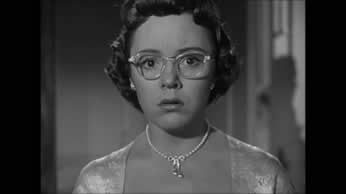Strangers on a Train (1951)
 Produced
and Directed by Alfred Hitchcock.
Produced
and Directed by Alfred Hitchcock.
Screenplay by Raymond Chandler and Czenzi Ormonde from a novel by Patricia Highsmith (better known for The Talented Mr. Ripley and the numerous books about Tom Ripley that followed it).
Like most film noir, Strangers captures some of the chaos and violence that hides beneath the seemingly placid surface of life. The anthropologist Clifford Geertz, in a famous essay about the Balinese Cockfight described the cockfight as not exactly portraying Balinese society as it is but rather, how the Balinese fear it might truly be...in the case of the Balinese, the staid formality and politeness of Balinese society is a superficial cover for something more like chickens mindlessly hacking each other to death. Similarly in Hitchcock, the glossy prosperity and superficial happiness of American society hides kindly old ladies who have fantasized detailed plans about how to commit murder.
In the movie, two people meet, seemingly randomly, on a train and one of them explains a plan for the "perfect murder" to the other. They will "criss-cross," each murdering someone for the other. The catch is, each does have someone they do want dead. One of them thinks (or claims to think) the other has agreed to swap murders. He kills the other's wife and then demands that the other kill his father. In the original novel, both murders are committed. In the film, only one. However, the underlying fact is that seemingly at random, a seemingly normal, person...in this case, one who has public popularity and connections to wealth and power, takes a trip on a train, and, by the time he gets off, has fallen into a previously hidden realm of violence and insanity. Wealth, power, prosperity is how life superficially seems, but there is another world, another America of violence, insanity, and fear that lies just below the surface. Which America is more real...and, maybe more disturbingly, does the glossy and prosperous America depend on the existence of the dark and violent America?
Staring:
Farley Granger (1925-2011) Guy Haines. Granger started in Hollywood immediately out of high school. Under contract with Samuel Goldwyn, he worked on numerous films in the 40s and 50s. He worked with Hitchcock on Rope in 1948 but Strangers was his final Hitchcock film. Granger went on to focus on musicals and on Broadway appearances. He played numerous roles on TV through the 80s.
Robert Walker (1918-1951) Bruno Anthony. Strangers gets much of its power from Walker's performance. Walker's boyish good looks and vulnerability made him a star in the 1940s. He played "boy-next-door" parts in films like See Here, Private Hargrove (1944) and The Sailor Takes a Wife (1945). Walker was, in many ways, an early version of James Dean or maybe even Heath Ledger. And like these, he had a deeply troubled personal life. He was an alcoholic and he struggled with mental illness. He died in August '51, just before Strangers was released, of a sedative administered by his psychiatrist. Walker is cast brilliantly against type in Strangers. Audiences were used to him playing sympathetic roles, not villains. Hitchcock uses the psychopath hidden beneath the "nice boy" charm of his earlier films. Walker's death almost certainly increased interest in the film.
Patricia Hitchcock (b. 1928) Barbara Morton. As noted previously, Hitchcock (pictured above) appeared in numerous films by her father as well as several others. Hitchcock more-or-less stopped appearing in films after Psycho (1960) in which she has a minor role. However, she was involved in several publishing projects including Alfred Hitchcock's Mystery Magazine and a book about her mother. Pat married Joseph E. O'Connell Jr., the son of a wealthy businessman and fairly famous racehorse owner. They had three daughters.
Ruth Roman (1922-1999) Anne Morton. Roman came from poverty and had tried to get into movies and plays starting in the early 1940s. She played bit parts for years but was seeing success by 1950 when Look Magazine billed her as one of the movie personalities of the year. She starred in westerns, noirs, and comedies in the early 50s but, by the late 50s moved to television. She had roles in a wide variety of well known TV series including Murder She Wrote, Knots Landing, Gunsmoke, and numerous others. In 1956, she and her son survived the collision and sinking of the ocean liner Andrea Doria one of the most famous maritime disasters in US history.
Reviews:
Roger Ebert's 2004 review (required)
Next: Short Subjects
Next: Musicals